The National Board of Chiropractic Examiners (NBCE) was incorporated in 1963 as a 501(c)(6) nonprofit organization. Since its inception, the NBCE has developed a series of four tests that are now required for licensure in every state in the U.S.
Through a 2008 confidential, 25-year agreement with the Federation of Chiropractic Licensing Boards (FCLB), the NBCE enjoys the exclusive support of the FCLB in that the latter agrees to "support and promote the use of the NBCE's examinations by chiropractic regulatory bodies in the United States," In exchange, the NBCE pays the FCLB 5 percent of what it charges chiropractic students to take examinations.
Raking in the Dollars
The NBCE's Annual Report 2020 shows that, with the impact of COVID, its exam revenue fell by about a $1 million, as did its expenses. This resulted in a change in net assets before investments, or what might be called excess income from operations, of $586,508. But the NBCE's $33 million in investments from prior years' excess income provided an additional $2 million – bringing its excess income to $2,588,312, which is higher than almost all previous years and a 51 percent increase from 2019.1
 To put this in perspective, the $2.5 million in excess income is equal to 20 percent of the NBCE's exam revenue. The nonprofit NBCE could have given the Part I exam free to all students in 2020 and still had excess income of more than $500,000.
To put this in perspective, the $2.5 million in excess income is equal to 20 percent of the NBCE's exam revenue. The nonprofit NBCE could have given the Part I exam free to all students in 2020 and still had excess income of more than $500,000.
Rising Exam Fees = More Revenue
To make matters worse, even with COVID's negative impact on chiropractic students and the NBCE's overwhelming projected 2020 net income, the NBCE Board voted in November 2020 to increase exam fees to students for all four parts and the physiotherapy exam beginning in 2021.
As could be expected, the NBCE's 2021 excess income was almost double that of 2020. The increase in exam fees created a windfall of $5,178,512 in excess income after investments. Even if the NBCE had administered both the Part I and Part II exams for free, it would have still shown excess income for the year.2
The 2021 annual report also shows that the NBCE made $1,098,966 in donations to various chiropractic organizations. If that money were applied to the cost of the Part III exam, it would reduce the cost of that exam by almost 40 percent. The total cost for a chiropractic student to take all four parts of the NBCE exam is currently $3,715. Based on the NBCE's Annual Report 2021, the NBCE could reduce its excess income and eliminate donations / sponsorships to reduce those fees down to about $2,200 total – and still have healthy excess income.
But Harder to Pass = More Revenue
What is perhaps even more alarming is that the failure rate for Parts I and II seems to be increasing. Some believe this is because the NBCE changes its "cut score" each year, which can increase the number of students who fail all or part of those exams (and also increase the NBCE's test revenue). The number of Part I and II retake exams shot up to 2,982 in 2021, which gave the NBCE additional revenue of $998,970. This is a 38 percent increase over 2020, as the number of retake exams was almost as many as the 3,407 Part II exams administered.
Important Questions That Need Answers: Where You Come In
When asked for a video interview, NBCE president Dr. Karlos Boghosian initially agreed, but the NBCE corporate attorney canceled the interview the day before it was scheduled. Since Dr. Boghosian declined to be interviewed to address these important questions, it is up to the chiropractic profession, particularly chiropractic students, to answer them for him. To do so, take our short survey now at www.dynamicchiropractic.com/why.
1. In 2021, the NBCE had excess income of $5,178,512. This is more than what all students paid for Parts I and II combined. Should the nonprofit NBCE rebate the money paid by chiropractic students for Part I and Part II exams ($710 per student per exam) in 2021?
2. Also in 2021, the NBCE donated over $1 million to other chiropractic organizations. Should the NBCE cease using student exam fees to make donations / purchase sponsorships to other chiropractic organizations and apply that money to reduce the exam fees?
3. Based on its 2021 financial figures, the nonprofit NBCE could reduce the total cost of the Parts I – IV exams from $3,715 to $2,200 by applying the donation / sponsorship money to reducing those fees and reducing its excess income. Should the NBCE reduce Parts I – IV total exam fees by at least $1,500 per student and keep exam fees at a level at which the NBCE's excess income from operations and investments is no more than 5 percent of its examination fee revenue?
There is no governing agency that oversees the activities of the NBCE. Your vote and voice matter a great deal. Only pressure from chiropractic students, doctors and organizations that care about our students and the future of our profession can force the NBCE to change. Please take the one-minute survey to provide your vote and your opinion on these important issues.
References
- Annual Report 2020. National Board of Chiropractic Examiners; PDF of report available at www.dynamicchiropractic.com/why.
- Annual Report 2021. National Board of Chiropractic Examiners; PDF of report available at www.dynamicchiropractic.com/why.
Dynamic Chiropractic editorial staff members research, investigate and write articles for the publication on an ongoing basis. To contact the Editorial Department or submit an article of your own for consideration, email
.




